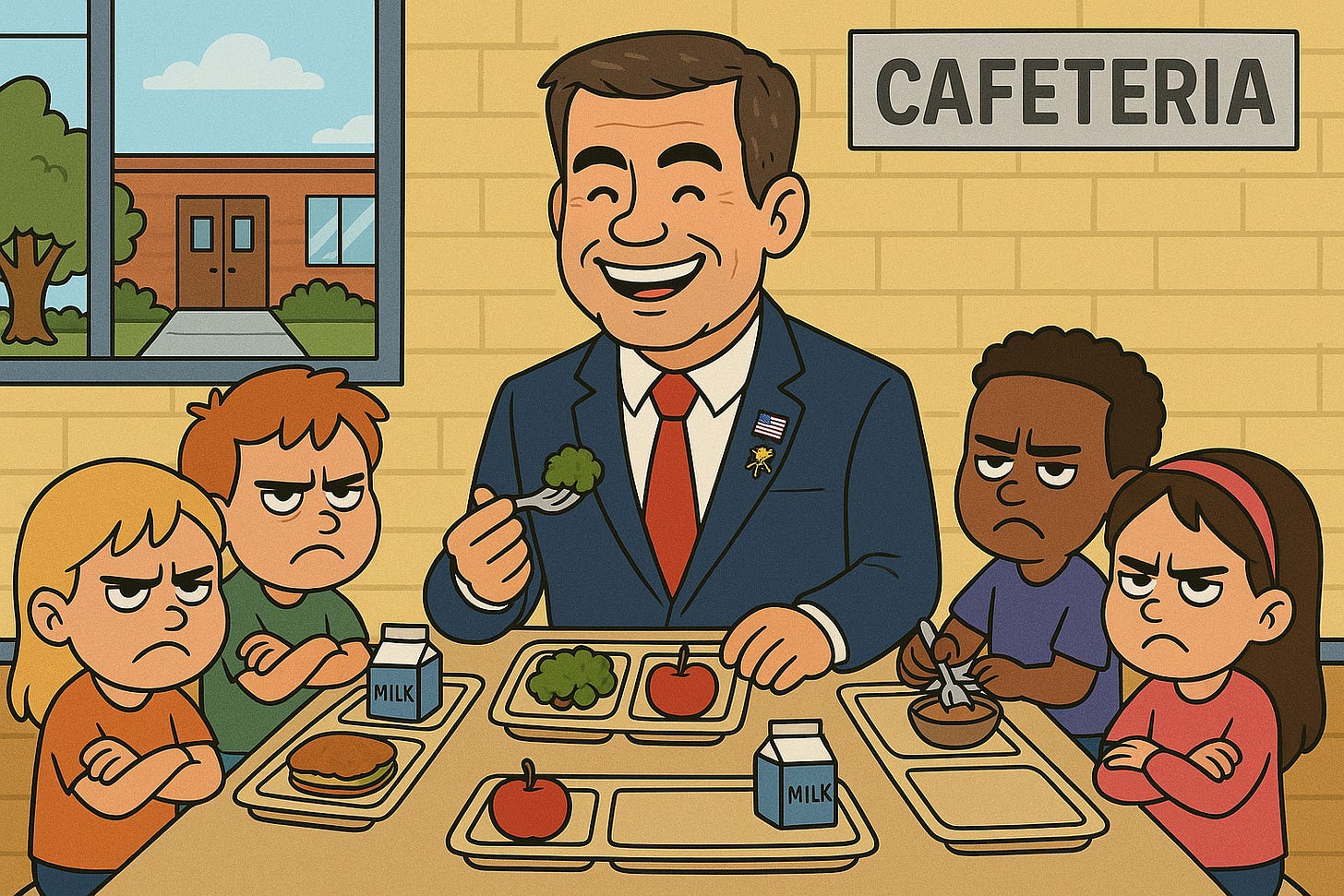Another way the GOP budget hurts VA-5's low-income kids
John McGuire voted against school meals for 50,000 students in our district.
A couple weeks ago, I wrote about how the Republicans’ budget, which Rep. John McGuire supports, will reduce cash and food benefits for 110,000 of our neighbors in the 5th district.
But their budget doesn’t just cut into the funding for these programs—it also makes them harder to qualify for. And, seemingly by design, it will force low-income families to go to much greater lengths to get school meals for their kids.
Why the new budget cuts kids out of the school meal program
The federal program for free and reduced-price meals is run by the U.S. Department of Agriculture, which makes the rules about who’s qualified to participate.
For most of the program’s existence, families qualified by submitting documentation to prove that their income was low enough—a process known as means-testing. Eventually, advocates for the poor started pointing out that many of those same families were already doing similar paperwork for other means-tested programs, like SNAP and TANF.
It was, they argued, an unnecessary burden on both individuals and the government. If a family has already qualified for, say, SNAP, why make them jump through the same hoops again?
So in 2010, Congress streamlined the process by removing means-testing for school meals. Since then, schools with a certain percentage of low-income kids have been able to offer free meals to every student—no more applications from each household. Schools get reimbursed according to the number of students who qualify for programs that are means-tested.
It’s a win-win: Everyone has less paperwork, more students get good food at school, and because nobody knows who qualifies and who doesn’t, kids don’t get called out for being on welfare.
The relevant section of the 2010 law, the Community Eligibility Provision, initially set the threshold so that this rule applied to schools where at least 40 percent of the students got SNAP or TANF. In late 2023, the government expanded access by dropping the threshold to 25 percent. The reconciliation bill now moving through Congress—the so-called Big Beautiful Bill—would hike it to 60 percent.
What does this mean for kids in VA-5?
In the 2023-24 school year (the latest for which data is available), 168 schools in our district met the qualifications for the CEP. Number of students at those schools: 77,274.1
If the cutoff goes up to 60 percent, 101 of those 168 schools will become ineligible. Number of students dropped from the program: 50,113.
In other words, the budget reduces the number of kids who benefit by two thirds.
I put the data into a spreadsheet so you can see for yourself how every school in VA-5 is affected.
Schools that become ineligible for the CEP will need to:
Collect household applications for free or reduced-price meals
Track every student’s eligibility status
Possibly charge students who don’t qualify.
On top of that, there’ll be less money to go around because Congress is making dramatic cuts to SNAP and TANF.
Also, yes, it is ironic that the party of DOGE wants to make poor families and educators do more paperwork. It’s almost like they don’t want people signing up for these benefits in the first place.
What to make of it all?
To me—just a guy sitting in his basement—it doesn’t seem crazy to suggest that a 25 percent threshold is too low. If one quarter of the kids at a school qualify for welfare and three quarters don’t, should all of them get free meals? But if not 25 percent, then what? Is 60 percent too high?
Yet I can also see it the other way: Arguably, the government should pay for every kid’s meal, as countries like Brazil, Estonia, Finland, and Sweden do.
I don’t know the answer, but it seems like a good conversation to have.
The problem is that we don’t get to have the conversation, because changes like this get made in the dark. That’s especially true when the entire budget is shoved into one massive reconciliation bill that no one will read in its entirety.
Where is John McGuire on all of this?
It’s also hard to have a conversation about a matter of public policy when your elected representative only shows up to talk with constituents in carefully managed events in front of friendly audiences. This criticism—that McGuire is dodging in-person encounters with constituents who will ask tough questions—seems to be landing with him. He’s now claiming that an unannounced meeting in Charlottesville last week was a meeting with constituents. I haven’t heard from anyone who knew about this meeting before it happened—folks who would know—and I haven’t seen any evidence that he announced it ahead of time.
McGuire vs. the mannequin
Speaking of town halls, my favorite part of this video from Indivisible Charlottesville—in which a woman presses McGuire on holding one—is where he says: “I don’t want to go to a town hall where they undress a naked mannequin and [inaudible].”
It’s true that, as the woman points out, Indivisible C’ville hasn’t done the mannequin bit.
But more to the point: This man was a Navy SEAL for eight years. He ran a campaign ad featuring him firing a big-ass sniper rifle. His online bio says he “did several deployments to countries across the world defending our nation against evil.”
But he’s afraid of a mannequin?
UVa students got their visas back
Update to my April 9 post: In early April, the State Department revoked the visa of an international student at UVa without explanation. Subsequently, State did the same to two more people associated with the university. All three now have their visas back.



Once again, thank you for this reporting. McGuire is getting another phone call this morning. Shameful behavior to take food out of the mouths of children.